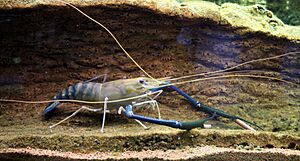Giant river prawn facts for kids
Quick facts for kids Giant river prawn |
|
|---|---|
 |
|
| Conservation status | |
| Scientific classification | |
| Genus: |
Macrobrachium
|
| Species: |
rosenbergii
|
The giant river prawn (scientific name: Macrobrachium rosenbergii) is a very large type of freshwater prawn. It's also known as the giant freshwater prawn. This amazing creature lives in tropical and subtropical parts of the Indo-Pacific region. You can find it from India all the way to Southeast Asia and Northern Australia.
People have also brought these prawns to places like Africa, Thailand, China, Japan, New Zealand, the Americas, and the Caribbean. It's one of the biggest freshwater prawns in the world! Many countries raise them for food. Even though they live in fresh water as adults, their babies (called larvae) need a mix of fresh and salty water, known as brackish water, to grow. Once they are bigger, they move into fresh water.
People call this prawn by different names around the world. Some names include Malaysian prawn, freshwater scampi (in India), or cherabin (in Australia). In Bangladesh and India, it's golda chingri. In Indonesia and Malaysia, it's udang galah. In the Philippines, it's uwáng or uláng. In Thailand, it's koong mae nam or koong ghram gram.
Contents
What Does the Giant River Prawn Look Like?

Giant river prawns can grow to be longer than 30 cm (about 1 foot)! They are usually brownish, but their color can change. Smaller prawns might look greenish and have faint stripes.
They have a very noticeable spike on their head called a rostrum. This spike has 11 to 14 teeth on top and 8 to 11 teeth underneath. Their first pair of walking legs is long and thin. These legs end in small, delicate claws, which they use for eating.
The second pair of walking legs is much bigger and stronger, especially in males. The claws on these legs are covered in thick, soft bristles, making them look velvety. The color of these claws in males can change depending on how dominant they are in their group.
You can tell females apart from males because females have wider bellies. Their second pair of walking legs is also smaller than the males'.
Different Types of Male Prawns
Male giant river prawns come in three main types, or morphotypes.
- The first type is the small male (SM). These are the smallest males and have short, almost clear claws.
- If conditions are good, small males grow and change into orange claws (OC). These males have large orange claws on their second legs. These claws can be 0.8 to 1.4 times as long as their body!
- Orange claw males can then change into the third and final type, the blue claw (BC) males. These males have blue claws that can be twice as long as their bodies!
Blue claw males are the leaders. They are territorial and control the orange claws, who then control the small males. If there are blue claw males around, it can slow down the growth of small males. It also delays orange claws from changing into blue claws. An orange claw male will keep growing until it's bigger than any blue claw male nearby before it changes.
All three types of male prawns can reproduce. Female prawns will mate with any male after they shed their old shell. Blue claw males protect the females until their new shells harden. Orange claw and small males do not do this.
Life Cycle of the Giant River Prawn
The female prawn carries her fertilized eggs until they hatch. This usually takes less than three weeks. A female can lay 10,000 to 50,000 eggs up to five times a year!
When the eggs hatch, tiny baby prawns called zoeae (larvae) come out. These larvae go through several stages while living in brackish water (a mix of fresh and salty water). After about 32 to 35 days, they change into postlarvae. These postlarvae are about 0.7 to 1 cm (0.28 to 0.39 inches) long and look like tiny adult prawns. Once they become postlarvae, they travel back into fresh water to live.
Why Are These Prawns Important?
Giant river prawns are very important for food around the world. They are often raised in special farms called aquaculture farms. You might also find them in places where people can go indoor shrimping for fun.


